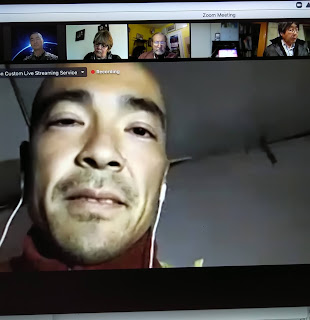Just before the Battle of Okinawa, Japanese troops on the archipelago decided to hole up in the southern end of the main island. However, Okinawan civilians had had the same idea long before. In the ensuing Typhoon of Steel, as the Battle of Okinawa became known, about a quarter of the Okinawan citizenry were killed.
The Garafuya (Okinawan dialect for "cave diggers") and various other citizen groups have managed to find remains of most but not all civilian casualties from 1945. But there are thousands as yet undiscovered, and now, their bones may well be transferred, along with limestone rock and island soil, to be dumped into Okinawa Bay to provide foundation for a proposed new Marine base to replace Henoko station. To drastically understate the matter, it is extremely worrisome to Takamatsu Gushiken and his fellow diggers that war victims' bones may be disturbed for no beneficial reason, and worse, to help shore up yet another American base. Read here, from Asahi Shimbun.
The entire situation is an emotional tsunami for Okinawa. Firstly, there is the fact of the death of many thousands of civilians--relatives, ancestors, community members, even small children and babies--in the course of the battle. Then there is the forced suicides brought on by Japanese troops' misinformation, coercion, direct gun-enforced order. Then there is the murder of family members and friends by terrified Okinawans, thinking that the American troops would brutalize them.
Rev. Shigeaki Kinjo was a teenager in Okinawa during the Typhoon of Steel. He and his older brother killed their mother and sisters, believing their action to protect them from American terror. That their action proved not only unnecessary but a terribly brutal act of murder profoundly affected the young boy. After a long silence, he finally spoke about it, especially as present day Japanese politicians an educators sought to bury the truth of what happened in an act of revisionist history. He is interviewed here.
In February and March, Takamatsu Gushiken staged a hunger strike on the grounds of the Okinawa legislature. Among those who joined him was Yuuichi Kamoshita, of the Buddhist Nichirenshu Nipponzan Myōhōji Temple:
Kamoshita-San was born in Tokyo, but in later life, having embraced the Buddhist principle of non-violence, he participated in peace demonstrations literally around the world. He is a resident of Okinawa since 2013. In the above photo, a screen shot from the 7th Global Inter-religious Conference on Article 9 of the Japanese Peace Constitution, Kamoshita-San is in a tent on the Okinawa legislature grounds in a hunger strike in solidarity with Gushiken-San. He had previously recorded a fine statement on the issues of faith and peace-making, clean-shaven and neatly dressed in clean robes against a pleasant background. Now, he was roughing it, hungry, working in a stubborn hope.
It was 5 o'clock in the morning, Eastern Time, when I saw this live segment, and I was profoundly moved that while we are talking about Article 9, about Okinawa and Guam, about militarism and peace, here was a participant putting himself where his words had been.
Gushiken-San has since suspended his hunger strike, satisfied that for now, his point has been made, while he and fellow Okinawans continue to comb the caves of Okinawa from the undiscovered bones of the war dead.



No comments:
Post a Comment